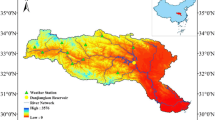Abstract
A method was developed to estimate a synthetic precipitation record for ungauged sites using irregular coarse observations. The proposed synthetic precipitation data were produced with ultrahigh hourly resolution on a regular 1 × 1 km grid. The proposed method was used to analyze selected real-time observational data collected in South Korea from 2010 to the end of 2014. The observed precipitation data were measured using the Automatic Weather System and Automated Synoptic Observing System. The principal objective of the proposed method was to estimate the additional effects of orography on precipitation introduced by ultrahigh- resolution (1 × 1 km) topography provided by a digital elevation model. The Global Forecast System analysis of the National Centers for Environmental Prediction was used for the upper-atmospheric conditions, necessary for estimating the orographic effects. Precipitation data from 48 of the more than 600 observation sites used in the study, which matched the grid points of the synthetic data, were not included in the synthetic data estimation. Instead, these data were used to evaluate the proposed method by direct comparison with the real observations at these sites. A bias score was investigated by comparison of the synthetic precipitation data with the observations. In this comparison, the number of Hit, False, Miss, and Correct results for 2010-2014 was 74738, 25778, 7544, and 367981, respectively. In the Hit cases, the bias score was 1.22 and the correlation coefficient was 0.74. The means of the differences between the synthetic data and the observations were 0.3, -3.9, -14.4, and -34.9 mm h-1 and the root mean square errors (RMSEs) were 2.7, 8.3, 19.3, and 39.6 mm h-1 for the categories of 0.5-10.0, 10.0-30.0, 30.0-50.0, and 50.0-100.0 mm h-1, respectively. In addition, in each range, the 60% difference between the synthetic precipitation data and the observation data was -1.5 to +1.5, -5.0 to +5.0, -17.0 to +17.0, and -33.0 to +33.0 mm h-1, respectively. Overall, the correlation coefficient of the synthetic precipitation data was > 0.7 for 43 of the 48 test stations and the RMSE was < 4 mm h-1 at 31 stations. The results are significant at all evaluation stations at the 0.05 significance level.
Similar content being viewed by others
References
Barnes, S. L., 1964: A technique for maximizing details in numerical weather map analysis. J. Appl. Meteorol., 3, 396–409.
Barnes, S. L., 1973: Mesoscale objective map analysis using weighted timeseries observations. NOAA Tech. Meso. ERL NSSL-62, National Severe Storms Laboratory, 60 pp.
Patrick, M. B., and C. Peter Keller, 1996: Multivariate interpolation to incorporate thematic surface data using inverse distance weighting (IDW). Comput. Geosci., 22, 795–799.
Bell, R. S., 1978: Forecasting of orographically enhanced rainfall accumulations using 10-level model data. Meteorol. Mag., 107, 113–124.
Collier, C. G., 1975: A representation of the effects of topography on surface rainfall within moving baroclinic disturbances. Quart. J. Roy. Meteor. Soc., 101, 407–422.
Haylock, M., and N. Nicholls, 2000: Trends in extreme rainfall indices for an updated high quality data set for Australia, 1910-1998. Int. J. Climatol., 20, 1533–1541.
Kessler, E., 1995: On the continuity and distribution of water substance in atmospheric circulations. Atmos. Res., 38, 109–145.
Kim, O.-Y., and J.-H. Oh, 2010: Verification of the performance of the high resolution QPF model for heavy rainfall event over the Korean Peninsula. Asia-Pac. J. Atmos. Sci., 46, 119–133.
Misumi, R., V. A. Bell, and R. J. Moore, 2001: River flow forecasting using a rainfall disaggregation model incorporating small-scale topographic effects. Meteor. Appl., 8, 297–305.
Menza, F. J., and D. Silva, 2009: Dynamic adaptation of maize and wheat production to climate change. Climate Change, 94, 143–156.
Moon, J.-Y., 2010: Daily Long Range Prediction of Precipitation and Temperature for 30 days using Quantitative Precipitation-Temperature Forecasting System. M. S. Thesis, Pukyong National University, 48 pp.
Roy, S. S., and R. C. Balling Jr, 2004: Trends in extreme daily precipitation Indices in India. Int. J. Climatol., 24, 457–466.
Sinha, S. K., and S. G. Narkhedkar, 2006: Barnes objective analysis scheme of daily rainfall over Maharashtra (India) on a mesoscale grid. Atmósfera, 19, 109–126.
Sinclair, M. R., 1994: A diagnostic model for estimating orographic precipitation. J. Appl. Meteorol., 33, 1163–1175.
Thiessen, A. H., 1911: Precipitation averages for large areas. Mon. Wea. Rev., 39, 1082–1089.
Author information
Authors and Affiliations
Corresponding author
Rights and permissions
About this article
Cite this article
Bae, HJ., Oh, JH. Study of method for synthetic precipitation data for ungauged sites using quantitative precipitation model. Asia-Pacific J Atmos Sci 53, 403–410 (2017). https://doi.org/10.1007/s13143-017-0038-z
Received:
Accepted:
Published:
Issue Date:
DOI: https://doi.org/10.1007/s13143-017-0038-z




